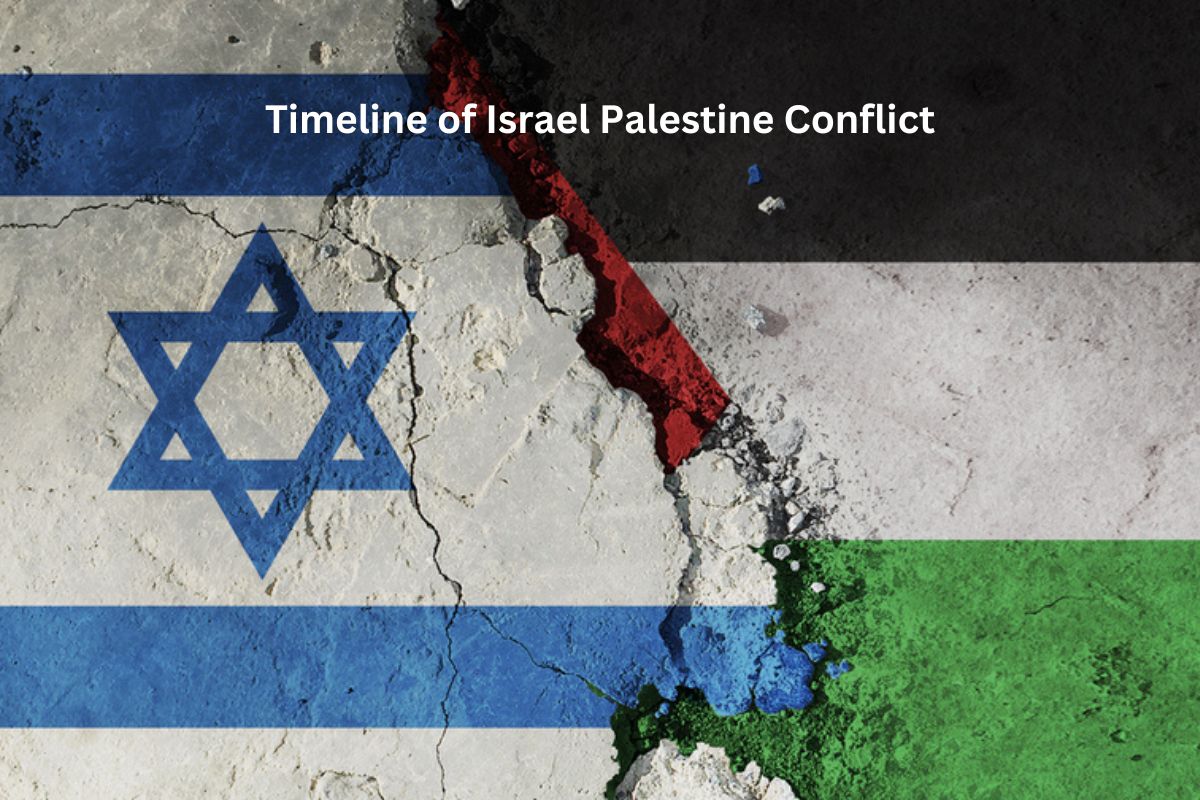The Israel-Palestine conflict is one of the world’s most enduring and contentious disputes. Rooted in historical, religious, and nationalistic claims to a relatively small region in the Eastern Mediterranean, it involves the competing national aspirations of the Jewish and Palestinian peoples.
Over the decades, this multifaceted conflict has evolved through various phases, shaped by regional wars, uprisings, political negotiations, and shifting geopolitical landscapes.
Attempts to find a lasting solution have been numerous, yet a comprehensive peace agreement remains elusive, with both sides holding deep-seated grievances and aspirations.
The conflict’s complexity is reflected in its impact on everyday life, regional politics, and international relations.
| Event/Period | Description |
|---|---|
| Ancient History | The region known as Palestine has been inhabited by various peoples for thousands of years, including ancient Jews and other Semitic peoples. |
| Roman Period | Judea came under Roman control in 63 BCE. Various Jewish revolts occurred, leading to significant Jewish diaspora. |
| Islamic Caliphates | In the 7th century, Muslim Arabs conquered the region, which then became part of several Islamic empires. |
| Ottoman Rule | From the early 16th century until WWI, Palestine was part of the Ottoman Empire. |
| British Mandate | The League of Nations granted Britain the mandate to govern Palestine after WWI. The Balfour Declaration of 1917 expressed Britain’s support for a Jewish national home in Palestine. |
| UN Partition Plan | In 1947, the UN proposed partitioning Palestine into Jewish and Arab states. The Jewish leadership accepted, while Arab leaders rejected it. |
| State of Israel & 1948 War | Israel was proclaimed in 1948 and was immediately invaded by neighboring Arab countries. By war’s end, Israel controlled more territory than allotted by the UN. |
| Six-Day War of 1967 | Israel captured the Gaza Strip, Sinai Peninsula, West Bank, East Jerusalem, and Golan Heights after a preemptive attack on Egypt, Syria, and Jordan. |
| Palestinian Liberation Organization (PLO) | Formed in 1964, the PLO aimed for the destruction of Israel but later shifted towards the establishment of a Palestinian state. |
| First Intifada | Started in 1987, it marked an uprising against Israeli rule with protests, boycotts, and clashes. |
| Oslo Accords | In the 1990s, the PLO and Israel reached several agreements, leading to the establishment of the Palestinian Authority (PA) with limited self-governance. |
| Second Intifada | Began in 2000 following the failure of peace talks and controversial visits to the Temple Mount/Haram al-Sharif. |
| Gaza Disengagement | In 2005, Israel withdrew its settlements and military from the Gaza Strip but maintained control over its borders, airspace, and coastline. |
| Hamas Control of Gaza | In 2007, Hamas took control of Gaza after winning elections and clashes with the rival Fatah faction. Israel and Egypt imposed blockades in response. |
| Recent Events | Several wars and skirmishes between Israel and Hamas in Gaza, with ongoing tensions and violence in the West Bank and Jerusalem. |
Israeli Palestine Conflict Timeline
1. Ancient History: Region inhabited by various peoples including ancient Jews
The land known today as Israel and Palestine has a rich history dating back thousands of years. In ancient times, it was home to some of the world’s earliest civilizations.
By the second millennium BCE, various Canaanite tribes occupied the region. The ancient Israelites, or Hebrews, who would later establish the Kingdoms of Israel and Judah, emerged in the late second millennium and early first millennium BCE.
Also Read: Facts About Arabs
The First Temple in Jerusalem was built under King Solomon in the 10th century BCE. The Israelites underwent various conquests and exiles, such as by the Assyrians and Babylonians, which had significant impacts on their history and identity.
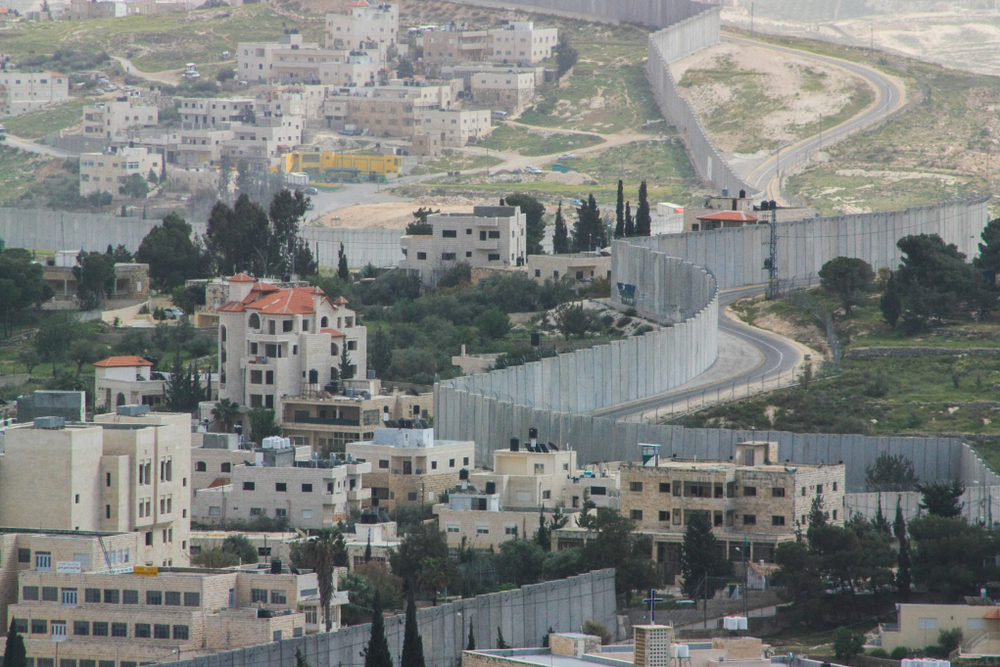
2. Roman Period: Judea under Roman control from 63 BCE
By the mid-first century BCE, Judea, which had been under the influence of various empires including the Egyptians, Persians, and Hellenistic Seleucids, came under Roman control. In 63 BCE, Roman general Pompey the Great annexed the region.
Also Read: Israeli Palestine Conflict Facts
The Jewish people experienced a turbulent relationship with the Roman authorities. This period saw two major Jewish revolts: the First Jewish-Roman War (66-73 CE), which led to the destruction of the Second Temple in 70 CE, and the Bar Kokhba Revolt (132-136 CE).
The latter resulted in significant loss of life, changes in the demographic landscape, and the renaming of the region by the Romans from Judea to Syria Palaestina, in an effort to diminish Jewish ties to the land.
3. Islamic Caliphates: Region under Islamic rule by 7th century
After centuries of Roman (later Byzantine) control, the region underwent a transformative change in the 7th century. Muslim Arab armies, after their conquest of Byzantine territories, took over Palestine around 636 CE.
The region then became part of various Islamic caliphates, starting with the Rashidun, then the Umayyads, Abbasids, and Fatimids.
The city of Jerusalem held special significance in Islam, leading to the construction of significant religious sites like the Al-Aqsa Mosque and the Dome of the Rock.
For centuries, Palestine became an integral part of the Islamic world, though it was often a battleground due to its strategic location and sacred status.
4. Ottoman Rule: Palestine part of the Ottoman Empire from 16th century to WWI
Beginning in the early 16th century, the region of Palestine came under the control of the Ottoman Empire, a vast state with its capital in Istanbul, that would dominate the Middle East for around four centuries.
Under the Ottomans, Palestine was relatively peaceful and was organized into several administrative districts. Throughout this period, the local population consisted of a mix of Muslims, Christians, and Jews, all living under Ottoman laws and regulations.
Toward the late 19th and early 20th centuries, the rise of nationalism and the decline of the Ottoman Empire saw increased tensions. Concurrently, the Zionist movement began advocating for a Jewish homeland in Palestine, leading to the early waves of Jewish immigrants to the area.
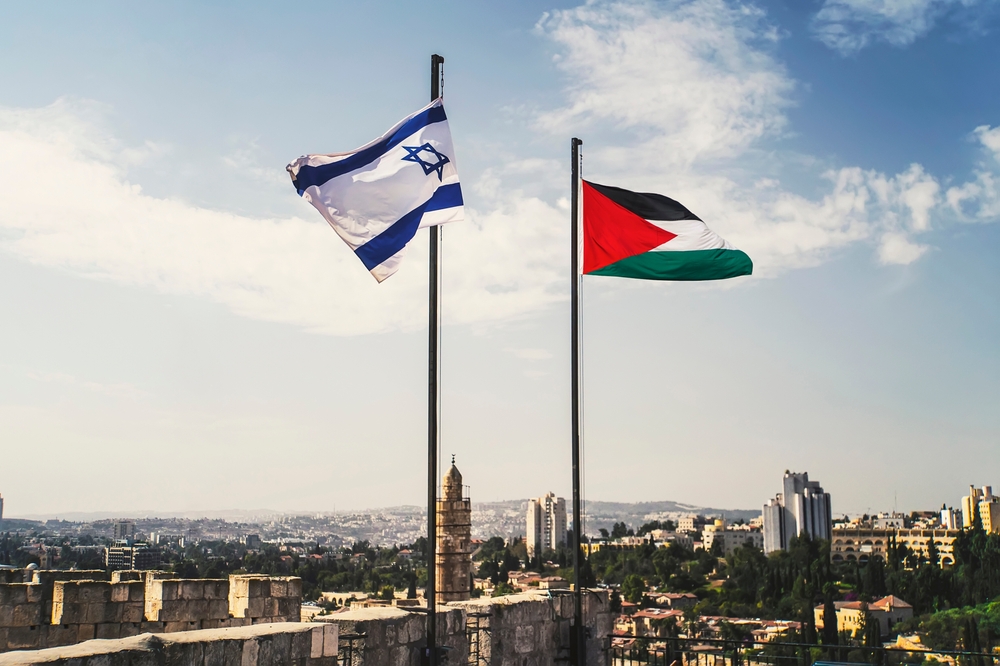
5. British Mandate: Britain governed post-WWI; Balfour Declaration in 1917
Following the defeat of the Ottoman Empire in World War I, Palestine came under British control. The League of Nations granted Britain a “mandate” to govern the region until it was ready for self-rule. In 1917, before taking control, the British government made a significant declaration known as the Balfour Declaration.
This document expressed Britain’s support for the establishment of a “national home for the Jewish people” in Palestine, without prejudicing the rights of the existing non-Jewish communities.
The Mandate period (1920-1948) was marked by significant Jewish immigration and land purchase, leading to demographic changes.
The growing Jewish presence led to tensions and periodic outbreaks of violence between Jews, Arabs, and the British authorities. As tensions mounted, Britain sought ways to address competing national aspirations, but by the end of World War II, they decided to turn the issue over to the United Nations.
6. UN Partition Plan: 1947 proposal to partition Palestine
By 1947, the United Nations was tasked with finding a solution to the growing conflict. The UN Special Committee on Palestine (UNSCOP) recommended partitioning the land into two states: one Jewish and one Arab, with Jerusalem as an international city.
On November 29, 1947, the UN General Assembly adopted Resolution 181, which endorsed the partition plan. The Jewish leadership, represented by the Jewish Agency, accepted the UN decision.
However, the Palestinian Arab leadership and the surrounding Arab nations rejected the plan, viewing it as a violation of their national and territorial rights.
7. State of Israel & 1948 War: Israel established in 1948; immediate conflict with Arab nations
Following the UN Partition Plan, tensions between Jewish and Arab communities in Palestine escalated into full-scale civil war. On May 14, 1948, David Ben-Gurion, head of the Jewish Agency, proclaimed the establishment of the State of Israel.
Immediately, neighboring Arab countries, including Egypt, Jordan, Iraq, Syria, and Lebanon, invaded the newly formed state. This conflict is known to Israelis as the War of Independence (or “Milchemet Ha’atzma’ut”) and to Palestinians as the Nakba (or “catastrophe”).
During the war, significant numbers of Palestinians either fled or were expelled from their homes, leading to a major refugee crisis.
By the time armistice agreements were signed in 1949, Israel had expanded its territory beyond the boundaries set by the UN Partition Plan, and the West Bank was annexed by Jordan, while the Gaza Strip came under Egyptian control.
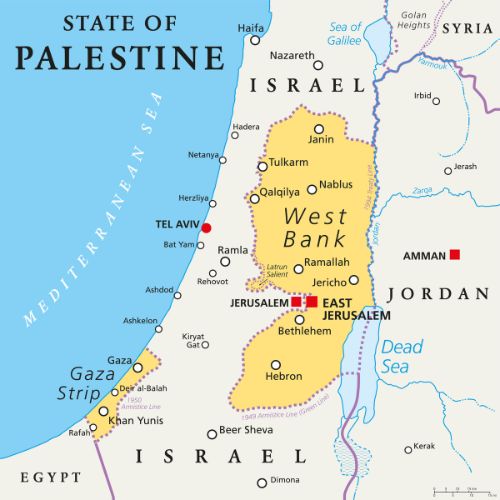
8. Six-Day War of 1967: Israel captured territories like West Bank and Gaza Strip
Tensions between Israel and its Arab neighbors continued throughout the 1950s and 60s. A combination of border skirmishes, political alliances, and regional rivalry culminated in a major conflict in June 1967, known as the Six-Day War.
Believing an Arab invasion was imminent, Israel launched preemptive airstrikes against Egypt, destroying much of its air force.
Within six days, Israel had defeated the Egyptian, Syrian, and Jordanian armies, capturing significant territories: the Gaza Strip and Sinai Peninsula from Egypt; the West Bank and East Jerusalem from Jordan; and the Golan Heights from Syria.
The war dramatically altered the geopolitical landscape of the Middle East and set the stage for future conflicts and peace negotiations.
9. Palestinian Liberation Organization (PLO): Founded in 1964 with shifting goals
Founded in 1964, the PLO aimed to achieve Palestinian national rights and initially advocated for the complete liberation of Palestine.
Under the leadership of Yasser Arafat and his Fatah movement, which took control of the PLO in 1969, the organization became more prominent internationally.
Throughout the late 1960s and 70s, the PLO used both diplomatic and militant strategies, which included acts of terrorism, to highlight the Palestinian cause on the global stage. In 1988, the PLO officially endorsed a two-state solution based on the 1967 borders.
10. First Intifada: Palestinian uprising against Israeli rule in 1987
By the late 1980s, frustrations among Palestinians in the West Bank and Gaza Strip reached a boiling point.
In December 1987, a traffic accident in Gaza involving an Israeli truck and Palestinian car, resulting in several Palestinian deaths, ignited widespread protests, demonstrations, and confrontations with Israeli forces.
This grassroots uprising, known as the Intifada (or “shaking off”), saw Palestinians, including children, using stones, Molotov cocktails, and general civil disobedience against the Israeli military.
The Intifada highlighted the need for a political solution, and it pressured both Israeli leaders and the PLO to seek a negotiated settlement.
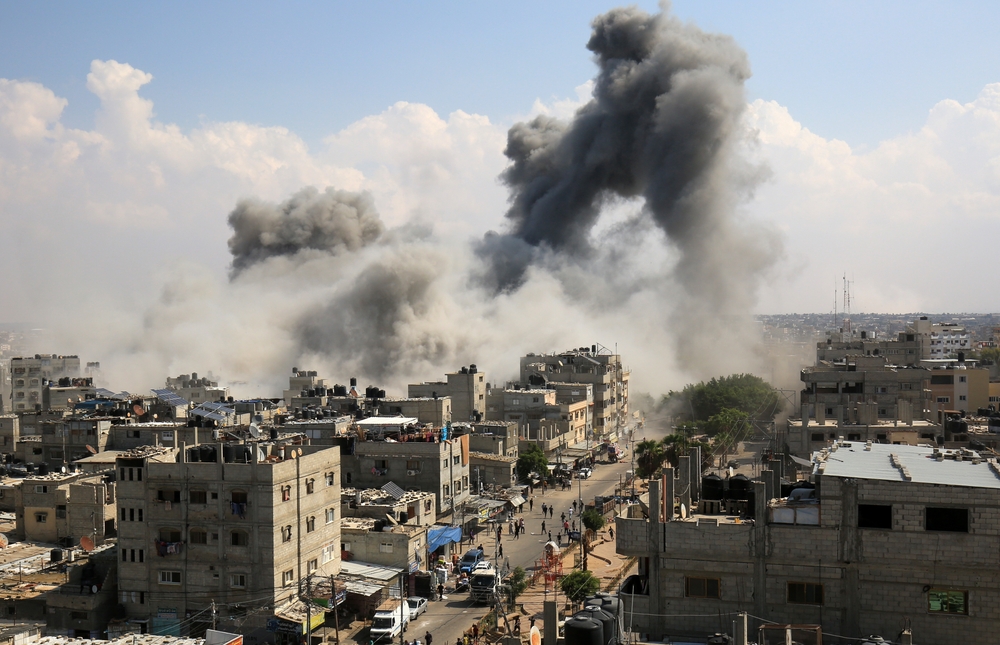
11. Oslo Accords: 1990s agreements between PLO and Israel
The early 1990s marked a significant shift towards the possibility of a peaceful resolution to the Israel-Palestine conflict. Secret negotiations between Israel and the PLO, facilitated by Norway, culminated in the 1993 Declaration of Principles, commonly referred to as the Oslo I Accord.
Signed on September 13, 1993, in Washington D.C., with a famous handshake between Israeli Prime Minister Yitzhak Rabin and PLO Chairman Yasser Arafat, the agreement laid out a roadmap for Palestinian self-rule in the West Bank and Gaza Strip over a five-year transitional period. The accords also established the Palestinian Authority (PA) to administer areas of self-rule.
The Oslo II Accord, signed in 1995, divided the West Bank into Areas A, B, and C, each with different levels of Palestinian and Israeli control. The hope was that these accords would lead to a final status agreement.
However, significant issues like settlements, Jerusalem, borders, and refugees were left to future negotiations, which proved to be major stumbling blocks.
12. Second Intifada: Violent uprising starting in 2000
Despite the optimism following the Oslo Accords, the peace process eventually stagnated, and disillusionment grew on both sides.
The Second Intifada, or Al-Aqsa Intifada, erupted in September 2000, following a controversial visit by Israeli opposition leader Ariel Sharon to the Temple Mount/Haram al-Sharif in Jerusalem, a site sacred to both Jews and Muslims.
This uprising was much bloodier than the first, with both sides experiencing significant civilian casualties from suicide bombings, military operations, assassinations, and other forms of violence.
The Second Intifada significantly eroded trust between Israelis and Palestinians and led to a hardening of positions. It officially ended around 2005, but its effects on the peace process and mutual perceptions were long-lasting.
13. Gaza Disengagement: Israel’s 2005 withdrawal from Gaza
In 2005, under the leadership of Israeli Prime Minister Ariel Sharon, Israel unilaterally decided to “disengage” from the Gaza Strip.
This involved the evacuation of all Israeli settlers—around 8,000 individuals—from Gaza and the dismantling of all Israeli settlements in the territory.
Additionally, Israel withdrew its military presence. The move was controversial in Israel and led to significant internal debates and protests. While some saw it as a necessary step towards a potential peace process and a way to improve security, others viewed it as a dangerous concession.
Following the disengagement, the Palestinian Authority initially took control of the Gaza Strip. However, the absence of Israeli settlements and military installations significantly changed the dynamics in the region.
14. Hamas Control of Gaza: Hamas took over Gaza in 2007
Hamas, an Islamist Palestinian organization that emerged during the First Intifada, gained substantial political power in the 2000s.
In 2006, to the surprise of many, Hamas won a majority in the Palestinian legislative elections. The ensuing tensions between Hamas and Fatah, the leading party in the Palestinian Authority, resulted in violent clashes.
By 2007, after a brief but intense conflict, Hamas established de facto control over the Gaza Strip, effectively leading to a split in Palestinian governance with Hamas in Gaza and the Palestinian Authority in parts of the West Bank.
Since then, Israel and Egypt have imposed blockades on Gaza, citing security concerns given Hamas’s declared intention to destroy Israel and its history of rocket attacks. The blockades, combined with internal mismanagement, have led to significant humanitarian challenges in Gaza.
15. Recent Events: Continued tensions, violence, and conflicts
The period following the Hamas takeover in Gaza has been characterized by periodic flare-ups of violence between Israel and Hamas, including several significant military operations.
Rocket attacks from Gaza into Israeli territory and Israeli airstrikes in response have become a recurring pattern. Efforts to achieve reconciliation between Hamas and Fatah and to revitalize the peace process with Israel have faced numerous challenges.
On October 7, 2023, Hamas-led Palestinian militant factions launched a coordinated surprise offensive against Israel. The morning offensive began with at least 5,000 rockets launched from the Hamas-controlled Gaza Strip into Israel.
Approximately 2,500 Palestinian terrorists crossed the boundary between Gaza and Israel and attacked civilian and IDF military targets in the Gaza Strip. The overwhelming majority of the at least 1,400 Israelis killed were civilians, including 260 at a music festival in Re’im.
